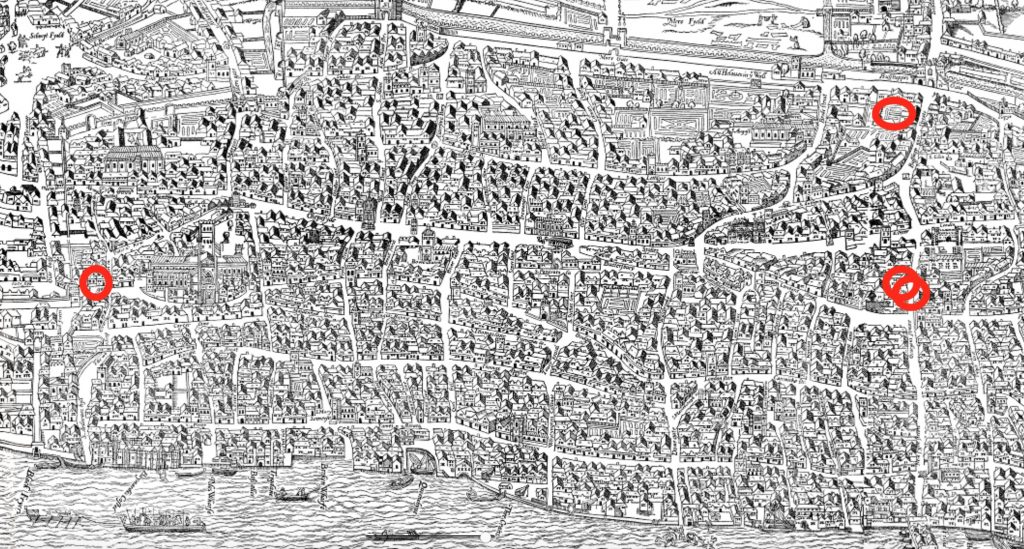This is the first of a mini-series of blogs reflecting on the Diverse Shakespeare at Shakespeare’s Globe programme led by myself and Mel in November 2021, which offered training sessions on the diversity of the early modern period to Globe Education Practitioners and volunteer tour guides at Shakespeare’s Globe. With the guidance of our external consultant Dr Onyeka Nubia (University of Nottingham) and Dr Will Tosh (Head of Research at Shakespeare’s Globe) we devised and ran four sessions over two weeks. The sessions aimed to equip staff with the information and skills to educate the public and educational groups that visit the Globe about the diversity of early English modern society. By working with the Globe’s guides and education practitioners, we aim to disseminate our materials with a large audience over a long period of time.
We divided the training workshops into two specific sessions. One session considered the diverse gendered and disabled bodies of early modern performers in the period, while the other session focused on early modern ideas of racemaking (i.e. the creation of ideas of race, ethnicity, and identity), evidence of performers of colour in the period, and how these tropes are embedded in or resisted by popular culture today. Each session was designed to support the organisation’s ‘one Globe’ approach to their anti-racist commitments, which seeks to empower all colleagues to inform the communities visiting the Globe, to counter any misinformation about the period and so to disseminate an inclusive understanding of the diversity present within the Shakespearean period.
In addition to equipping participants with the intersectional knowledge to contextualise early modern performance cultures, the sessions also provided a ‘toolbox’ to support attendees to reappraise the Shakespearean texts that we think we know inside out. We asked participants to rethink how markers of difference were achieved in early modern performance – such as how Black or disabled characters were depicted on the Shakespearean stage – while exploring the pervasive ways in which systems of oppression are so deeply embedded in material from the period that they might be rendered invisible. Drawing on rich fields of scholarship, the sessions dedicated time to identify specific terminology that signposts misogynistic, ableist, and racist attitudes, exploring how these references might be connected to wider networks of early modern culture. There’s nothing harder for an academic than answering a seemingly simple question from a member of the public: these questions send us back to first principles and push us to think and communicate more clearly than any other. Because of this, the training sessions aimed to support Globe staff answer these kinds of open, general questions from the enthusiastic publics who visit their building or take their classes and who are seeking to understand the Shakespearean period more deeply. Some of these overarching questions included:
• Did women perform in early modern England?
• Were there performers of colour on the early modern stage?
• What value is there in producing/performing/studying texts that include problematic content?
• What methods best allow us to negotiate this content in a meaningful way without repeating the violence of the past?
• Was Shakespeare racist?
We found these questions, some intentionally provocative, very useful to draw out conversation, find nuance and demonstrate how complex lived experiences can be rendered (in)visible on both page and stage. While these conversations might be difficult or uncomfortable, they encourage people to reflect not only on their own relationship with these well-known plays but also their position in the present world. We intended to create a safe space for volunteers and education practitioners to build the confidence to contribute and lead these discussions at the Globe. However, in building and running the sessions, we encountered a similar sense of self-reflection. While preparing the sessions, we found questions arising about curation. Providing an overview of any marginalised community in history can be daunting and challenging, with limited time to discuss extant archival records, textual clues, and visual material such as artwork or emblems. While these sources contribute to a rich tapestry of lived experiences and communities, almost inevitably, we would never be able to talk about every account or voice. Building the sessions, we spent time thinking about what materials we include and exclude, as well as how these curatorial decisions might impact the shape of the sessions and thus, the breadth of diversity presented to attendees. How do we ensure we do justice to the lives often rendered invisible through hostile archival practises? How do we recover the humanity that historically has been diminished or queried?
This three-part series will respond to these questions, as we rethink diversity in Shakespeare and beyond. In the following two entries, Mel and I will each detail the content of our respective sessions. This includes the archival evidence demonstrating female, trans, non-binary and gender non-conforming performers across a range of cultures of performance in England; how the popular early modern maxim ‘to wash an Ethiop’ has permeated and resurfaced in present-day popular culture; critically appraising a taxonomy of terms that might refer to diverse, and often marginalised identities in the early modern period. In doing so, the series will act as an experiential reflection to consider how notions of diversity operate in Shakespeare and his contemporaries, and how we receive or respond to these representations today.
The Diverse Shakespeare at Shakespeare’s Globe project was made possible by funding from the Southlands Methodist Trust (SMT). This public engagement project called on the research findings of Engendering the Stage, funded by the Leverhulme Trust. Special thanks must go to Dr Onyeka Nubia at the University of Nottingham and Dr Will Tosh at Shakespeare’s Globe for supporting this project and so generously sharing their time and expertise. Thank you to Shakespeare’s Globe staff and volunteers, whose kind welcome and thoughtful participation made for excellent discussions. We look forward to sharing more about the work from this project on this blog in the coming weeks!


